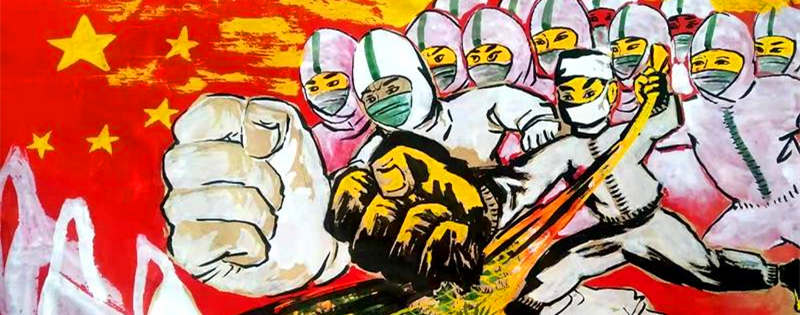Now it is the end of 2020, a year many people would never forget. The outbreak of COVID-19 turned out to be a global pandemic. China was the first victim of the extremely contagious virus. After the painstaking efforts in the first 3 months of this year, China has conquered COVID-19. How could China make it? Let us explore the reasons from 3 aspects: Government, healthcare services and society/people.
Why and How Could China Beat the Virus of COVID-19 – What Have Government Done?
A strong government with a dominant ruling party can make quick decisions and achieve the goal by fully utilizing the national resources. Here below are the major approaches the Chinese government took to put the epidemic under control。
1. After many studies in the country confirmed human-to-human transmission, and due to the rapid spreading within Hubei province, the Chinese authorities expanded the range of its preventive measures and announced a lockdown in Wuhan and other cities in the province on January 23, by closing the airports and suspension of all public transportations to prevent anyone from entering and leaving. This announcement was made one day before the Spring Festival (Lunar New Year) in China in order to reduce the largest population migration at this time, thus preventing the spread of the disease. In addition, shops were all shut except those providing food and medicine, and very tight restrictions were placed on people to force quarantine. The government also cancelled activities with large crowds and postponed the reopening of schools and colleges by extending the holiday. Great efforts were put in to educate the general public on the seriousness of COVID-19. Moreover, the authorities announced that the government would pay for the medical expenditures for COVID-19 patients including the test and treatment on Jan 22. The low-income people can also be treated equally in hospital, which help to extinguish the transmission completely.
2. When Wuhan side asked for the urgent assistance, the central government immediately organized first 450-member medical team from 3 military medical colleges and hospitals to reach Wuhan on the eve of lunar New Year, the most important family reunion time for Chinese like Christmas in West. In the following days, more medical teams were on their way to Wuhan and neighboring towns in Hubei Province. According to the final statistics, between Jan. 24 – Mar. 1, 344 medical teams from 30 provinces were dispatched to Hubei Province, totaling 42,322 persons (including 11,416 doctors and 28,679 nurses). They were all wide spread in different hospitals of different towns in the province, working together with the local public health workers. This is one advantage of a centralized government in a big country.
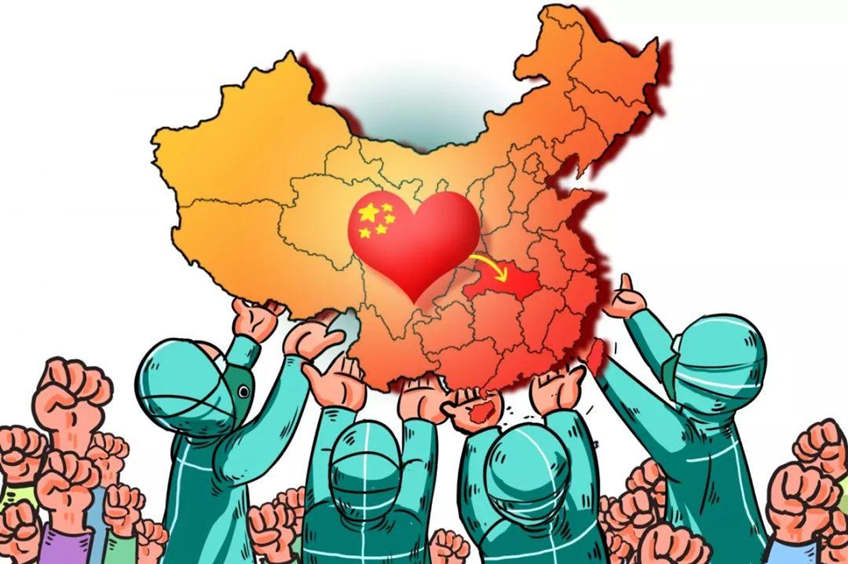
3. On Feb 7, the state council announced that the 16 cities in Hubei province that have been badly hit by the outbreak of COVID-19 would be in partnership with a province or municipality in the country (19 in total). One or more designated provinces or municipalities will offer the necessary aids (medical personnel and supply, food, etc) to one epidemic area. This is one characteristic of Chinese political system. It might be a bit hard for the governments of other countries to understand and follow. The Chinese central government has the strong hold of all the resources. Once there is an overwhelming natural disaster, epidemic, or other emergencies in one place, the state can manage to deal with the issues on site by bringing the needed supplies from other regions before the situation worsens.
4. Due to the lack of hospital beds and facilities, the government modeled the experience of establishing Xiaotangshan Dedicated Hospital for SARS patients in Beijing in 2003. On Feb. 2, a 1000-bed Huoshenshan Hospital was built up in just 10 days and put into use in the following day to relieve the overstressed medical system in Wuhan. The building and auxiliary facilities encompass 33,900 sqm, and include space for 1,000 beds. During peak of construction, more than 1,000 project managers and 5,000 workers worked 24/7 using nearly 1,000 large-scale pieces of equipment and transport vehicles on site to complete the construction at a breakneck pace. The hospital contains advanced technology and has a higher level of protection and isolation compared to existing infectious disease hospitals. Components include a negative pressure ward, intensive care room, CT room, operating room and laboratory. 4 days later, another 1600-bed Leishenshan Hospital was finished to welcome the new patients. The amazing project speed saved more lives.
5. In order to meet the demands of different districts of Wuhan, the local government transformed a number of gymnasiums and exhibition centers into temporary hospitals. A total of 16 shelter hospitals were set up in different corners of Wuhan, with more than 15,000 beds, and 12,000+ patients with mild-to-moderate symptoms have been admitted. One out of every four COVID-19 patients in the city was cured in these hospitals. Patients who started to show symptoms of severe disease were quickly transferred to conventional hospitals. In this way, all the patients can be isolated in a place with good medical care. It is an effective way to reduce the risk of infections among family members. On Mar. 10, 2020, the last temporary hospital at Hongshan Gymnasium of Wuhan waved goodbye to the last 49 cured patients and closed.
6. Based on the WHO experts’ suggestion, the Chinese authorities prioritized active, exhaustive case finding and immediate testing and isolation, painstaking contact tracing and rigorous quarantine of close contacts. It is actually very important, even in the post-epidemic period. Any neglect may lead to the second wave of COVID-19 outbreak, the authorities are vigilant about this extremely contagious virus. Once one new case is found, mass nucleic acid tests will be launched to ensure all the patients included asymptomatic ones can be isolated and well treated. On Oct 11, a new outbreak of the coronavirus has been reported in Qingdao city of Shandong province: 12 locally transmitted cases were found in Qingdao Chest hospital. The local authority immediately announced a plan to test all city residents as soon as possible. As of 18:00 on October 16, Qingdao had all completed 10,899,145 nucleic acid tests just within 5 days, and the test results were all negative. To achieve the mission impossible, Shandong Province coordinated and arranged 5 neighboring cities: Zibo, Yantai, Weifang, Weihai, and Rizhao to carry out counterpart cooperation with 5 districts in Qingdao to receive nucleic acid samples for testing; 7 additional nucleic acid testing teams with 210 people and 28 sets of nucleic acid testing equipment were sent to aid Qingdao with 56,000 reagents; organize nucleic acid sampling teams of more than 1,000 people from other cities in Shandong Province to assist sample collection. With all the efficient measures, tens of thousands of medical staff plus volunteers and government workers implemented nucleic acid sampling and testing in Qingdao at hundreds of temporary nucleic acid test spots, working from 5:30 in the morning to 23:30 in the middle of the night.
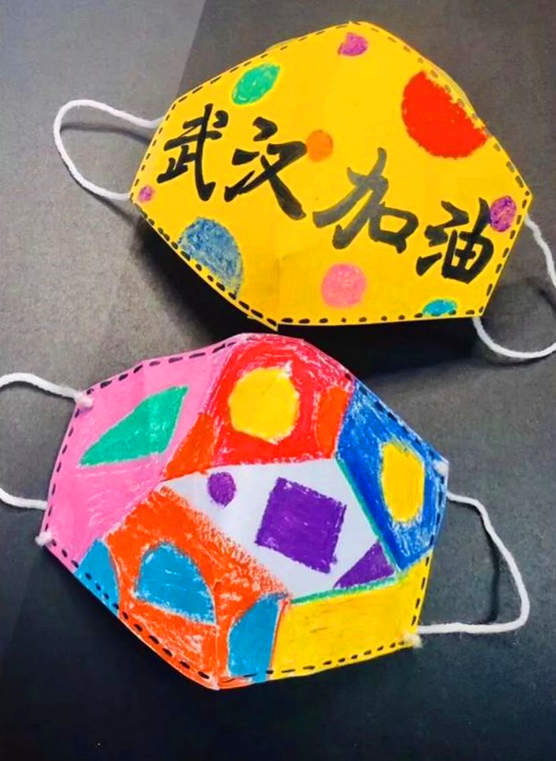
Why and How Could China Beat the Virus of COVID-19 – about Healthcare services?
Ms. Zhang Jixian, Director of Department of Respiratory and Critical Care at Chinese-Western Medicine Hospital of Hubei Province first found this was a severe contagious respiratory disease on Dec 26, 2019 and reported it to the administration of the hospital on the following day. Then it was immediately reported to CDC Wuhan. On 31 December 2019, the WHO China Country Office was informed of cases of pneumonia of unknown etiology detected in Wuhan City, Hubei Province of China, which was published on their official site. By January 7, China CDC has isolated the first novel coronavirus strain, and three days later, the Wuhan Institute of Virology and others developed testing kits.
On Jan. 11, Prof. Zhang Yong-zhen of Fudan University in Shanghai and his team posted the genetic sequence of the virus on an open-access platform, sharing it with the world. More medical organizations including China CDC and two other Chinese teams published genetic sequences of the virus on an open-access platform. The National Health Commission announced that China would share the virus’ genomic sequence with WHO on the same day. Based on the valuable genetic information, the virologists in the world can develop the vaccines the soonest.
No matter the local medical staff in Hubei, or those from other provinces, they are all the real warriors and heroes during the campaign against novel corona virus. Most of them could have stayed at home celebrating the Spring Festival with families. The 84-year-old epidemiologist Mr. Zhong Nanshan, 73-year-old epidemiologist Ms. Li Lanjuan and thousands of other medical workers joined the battle against the virus and made their own contributions. Under the critical situation, many of them gave up their holiday and worked hard in hospital day and night. They couldn’t return home during the period. Lack of rest and sleep, many of them just slept in a chair, even on the ground. Wearing a thick medical isolation gowns, the medical staff got soaked with sweat after one day work. From the beginning to the peak of the epidemic, the public health services in Wuhan have experienced a tough and challenging time. Not only did the medical staff themselves got infected, and some passed away at work, but also their family members were infected, and their lives were badly affected. All the medical staff working on the frontline took on unbearable psychological and physical pressure in the period. After the painstaking efforts, they made it to beat the virus in the speed race. We should pay high respect to them.
Thanks to the effective work of Chinese virologists, the government has approved three COVID-19 vaccine candidates for clinical trials on April 14. Later two more types were created and underwent the phase 3 trial as well. All these vaccines were not only tested in China, but in other countries like Brazil, Indonesia, Pakistan, Peru and UAE, etc. These vaccines are mainly produced based on traditional inoculation methods such as inactivating the virus. These Chinese-developed vaccines can be stored in regular fridges, making distribution much easier and cost effective. All of them would definitely help China and rest of world to beat the virus.
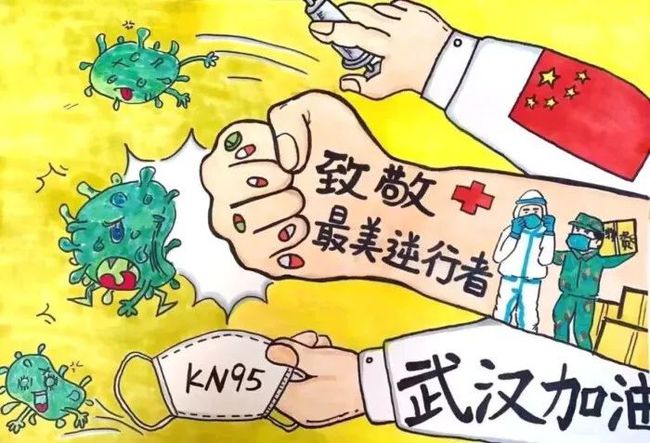
Why and How Could China Beat the Virus of COVID-19 – What Have Society and Chinese People Done?
Wuhan is the capital city of Hubei province, with a population of 11 million. It would never be easy to lock down the metropolis and transportation hub in the center of the country, especially during the lunar-year-end holiday season. After a good lesson of SARS in 2003, Chinese government acted much more quickly and mobilized the whole society to fight against the virus. Like what Dr. Bruce Aylward said, “This approach of all-of-government and all-of-society has probably prevented at least tens of thousands, even hundreds of thousands of cases”. He was the Team lead of the WHO-China Joint Mission on COVID-19 held in Feb 16-24.
Here we have to mention a less known word in West - “Juweihui”, literally Neighborhood Committee, it is the basic-level administrative organization in the cities of China. It was designed to maintain the public security and provide mutual aids in neighborhood, and began in 1950’s. After 1980’s, the organization has more functions like birth control, management of the retired, etc. A strong government was not enough to carry out its public policy and regulations, 1200+ neighborhood committees scattered in different districts of Wuhan took over the duties to communicate with the average people. The staff members are also responsible for implementing mandatory quarantine throughout the city:
- Educating the people to thoroughly follow the government rules, not to get spun by internet rumors and teaching them how to protect themselves scientifically from COVID- 19;
- Patrolling in their jurisdiction, persuading people not to break the rules, and setting up temperature checkpoints at the entrance of the neighborhoods to monitor people who went in and out;
- Guaranteeing the food supply and daily necessities for the residents, bringing more convenience to them due to lockdown;
- Taking good care of the senior and handicapped in the district;
- Registering the people newly arrived, and reporting the suspected cases to local CDC, helping them to transfer to the hospital if needed.
With the great efforts of the service staff at “Juweihui” and volunteers, millions of the residents stuck at home remained stable psychologically without hassle and worry, which soon helped to break the chain of infection successfully. It was estimated by Chinese epidemiologists that the effective lockdown measures in Wuhan avoided 96% new infection, therefore, it might cause some inconvenience in a certain area, but rest of the country kept much safer, which could conversely support it to get out of trouble soon.
The cultural background and Chinese people’s mindset are very different from that of the West. China is a vast country. In the history of agricultural civilization, Chinese people witnessed so many natural disasters like flood, earthquake, epidemic, etc. From the depth of the minds, we tend to unite and work together to fight against the adverse situation. Therefore, once something unexpected happens, most of the Chinese would expect a powerful government to lead them to go through the hardship. This is why the average Chinese are more obedient, disciplined, and cooperative of the approaches of authorities. Wearing a mask is not an issue at all in China. The collectivism is always paramount compared to individualism.
On the other hand, it was not a government order, but thousands of doctors and nurses from other provinces volunteered to join the medical team to head for Wuhan during the dangerous time to assist the local peers to battle the virus, as they thought this was their obligation and duty. Many of them are CPC members. As of March 8, 53 persons working in neighborhood committees all over the country died from COVID-19 due to the infections in the workplace, 49 of them were members of the Communist Party. In this sense, Chinese people do value the social responsibility under the leadership of the Communist Party.
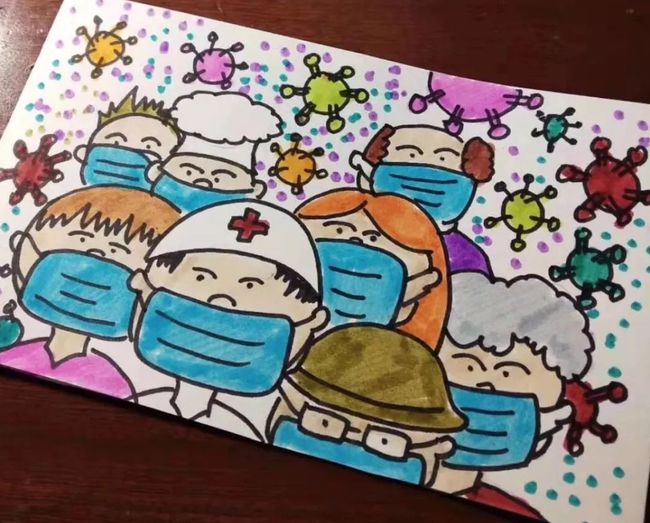
Why and How Could China Beat the Virus of COVID-19- Conclusion
Once Chinese people of the whole country got unprecedentedly united, it will generate a great impetus to facilitate the society to put the virus under control. On March 19, China's National Health Commission announced that the 34 new cases it had to report were all from overseas. This milestone indicated China had defeated the corona virus. From the outbreak of SARS in 2003 to today, we saw tremendous progress of this country in handling urgent public health challenges. Still we have to say it was far from a flawless job during the campaign against COVID 19. There were many lessons and experiences the government, healthcare services and society should review and study, which will definitely help the country to get more mature and move forward.
Further Reading:
